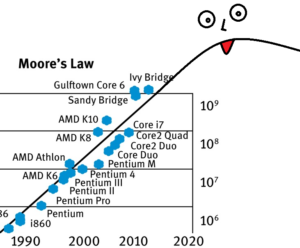Hardware Startups too Hard? Lack of Hardware Innovation & Its Limitations
I have heard it mentioned a few times in class that software is becoming the dominant player in a market that used to be controlled by hardware. It makes sense, as we see the development of cloud computing, virtualization, & shared resources utilizing complex software on just a few machines. One of the key notes from articles is that we are waiting for software to catch up with hardware.
But, looking back at Moores Law that our Professor mentioned in one of our earlier lectures, I couldn’t help but wonder if there would soon be a paradigm shift back to hardware companies. As we see the decrease of computing power from the graph below, we are entering a time when our manufacturing & technology limitations are realized in another market. I often heard that we had all this data & computing power, but we did not know what to do with it; Hence, a large dominance in the software industry.
 Moores Law [1]
Moores Law [1]
As we move to a realm of required instantaneous decision making, such as in autonomous vehicles, is lag in computing allowable? Take for instances Tesla, whose autonomous driving software suite needs the computational power equivalent to 150 MacBook Pros. A microsecond delay compounded could result in a life or death situation for this new age of software meant to handle fully autonomous driving. I can’t help but wonder as the software industry catches up and begins to utilize all the resources of our hardware, & as our limitation in hardware computing hits a wall, are we up for a shift in start-up companies? Maybe hardware companies will no longer be the hard startup & we will see a shift in dominance.
While some of these performance indicators are predictable, I propose yet another area of new learning that will eventually shift our dominance back to a hardware market; Deep learning – a strongly emerging market that sets the foundation for what many of us consider the true depiction of AI (a machine that learns, understands, and processes data much like you or I, just at a much faster rate with better efficiency).
 Machine Learning vs. Deep Learning [2]
Machine Learning vs. Deep Learning [2]
My opinion is that as we move to deeper learning, complex computations, & a transition of safety into technologies hands, we will see regulations placed on computational requirements for the software we will trust our safety to. As we move to a world were machines begin to replace humans from mundane tasks to safety critical tasks (driving, surgery, etc.) we will see restrictions set on minimum hardware requirements that the software needs to run, & those restrictions will not be based on a belief of the developer, but on regulations set by an Industry Guideline, which might well exceed the allowable hardware capabilities we currently possess.
[1] thehardtime.com/moores-law-sad-no-one-believes-anymore
[2] www.airector.com/2018/03/22/why-artificial-intelligence-is-powerful/
2 comments on “Hardware Startups too Hard? Lack of Hardware Innovation & Its Limitations”
Comments are closed.


Hey Colby!
Great article on a possible future of the tech industry. Deep learning is a really interesting emerging market and I am glad you also pointed out the role of regulation in it. Regulation is most certainly necessary to hold firms accountable – especially when a mistake in software or hardware can result in a loss of life as in the case of autonomous vehicles.
Regarding the guidelines, who do you think should be in charge of suggesting/implementing them? Also, in terms of deep learning technology, what steps do you think the industry should take to move faster into deep learning? What kind of hardware is required to support deep learning?
Industry guidelines seem like a curious idea for making sure that the hardware is capable of running the software and delivering the solutions quickly enough for our needs. I would find it difficult to believe that a single blanket hardware requirement could over all use cases. Software implementation varies greatly between vendors and manufacturers, making minimum requirements somewhat arbitrary and nebulous.
Perhaps the industry will move toward these guidelines from the opposite direction: instead of setting minimum hardware requirements, perhaps it will set maximum allowable lag time in certain action/reactions. This would allow manufacturers to choose their hardware implementation to suit their needs while still ensuring that the product meets safety and reaction requirements.